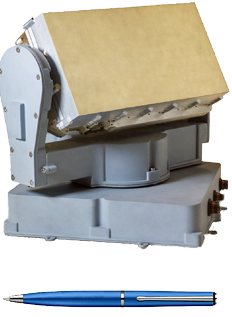Unmanned Aerial Systems (UAS) have become an essential component of tactical military operations—also known as Unmanned Aerial Vehicles (UAVs) and RPAs (Remotely Piloted Aircraft), these platforms offer defense organizations numerous advantages over manned platforms.

First and foremost, UAS units reduce the risk of casualties and lives being lost. They are also capable of performing long endurance missions, beyond the limits of any human pilot. In terms of cost-effectiveness, the flight hour cost of a UAS is substantially less than that of a plane or a helicopter.
UAS are used as force multipliers. They provide real-time Intelligence, Surveillance and Reconnaissance (ISR) information on remote targets and areas, as well as damage assessment and electronic warfare. They are also commonly used in border control as well as anti-terror operations.
Tactical UAS Trends for the Military Sector
To meet the needs of today's military and information-gathering missions, UAS continue to evolve at a rapid pace. This evolution is especially evident in two key areas:
• Operating range and endurance are getting longer—Depending on the type of platform, UAS can fly for periods of up to 30 hours without refueling, while operating ranges can reach thousands of miles. A fleet of alternating UASs can indefinitely cover an area of interest.
• The physical size of UAS is getting smaller—Defense organizations are focusing on miniaturization. The challenge is to reduce the size, weight and power consumption (SWaP) of UAS-installed devices, such as sensors, all without compromising on performance. This size reduction affects all subsystems, including communications, radars and electronic warfare.
There are many different types of UAS, designed for different purposes. In the military segment, UAS are categorized into groups based on their size, weight, speed and operating altitudes. The smaller tactical unmanned platforms are commonly used for medium to lengthy endurance missions.
Group 3 UAS includes the Lockheed Martin Fury 1500, Insitu (Boeing) Integrator, Northrop Grumman BAT 12 and others—these UAS craft operate at medium altitudes (typically 15,000 feet) with medium to long range and BLOS (Beyond Line Of Sight) communication capabilities and have much-needed endurance. With a payload capacity of less than 100 pounds, they typically carry multiple sensor packages (e.g., FMV, SIGINT, jamming) and can be fitted to carry a SATCOM terminal.
The Need for BLOS Comms
The combination of longer endurance missions and a smaller, lighter form factor has had a major impact on UAS communication requirements. Tactical UAS units, in particular, require low-SWaP communication systems for delivering high definition ISR imagery, while maintaining a dependable Command and Control (C&C) uplink with the supporting ground station.
Due to the increased distances in long endurance missions, Line-Of-Sight (LOS) communication solutions are no longer feasible. In the past, in order to support BLOS communications, UAS aircraft relied on ground-based or airborne repeater stations. This type of solution is not appropriate for tactical operational scenarios, which are dynamic and time-sensitive.

The Gilat BlackRay 72Ka. The smallest SATCOM system for UAS . Size: 11.8 (d) x 9.5 (h) inches (30 x 24 cm).
SATCOM to the Rescue
SATCOM is the natural and preferred solution to provide reliable, real-time BLOS connectivity. SATCOM uses geostationary satellite capacity to provide full-duplex communications, linking the UAS to its ground control station.
Satellite coverage can span an entire continent, which is ideal for long-range UAS missions. SATCOM enables seamless BLOS communications between the UAS and the ground station without having to deploy relay equipment on the ground or on another aircraft.
Moreover, improvements in satellite technology, particularly the emergence of HTS, make SATCOM even more attractive for the UAS market. HTS satellites, which transmit over Ka-band, provide an estimated 300 to 400 percent improvement in throughput over traditional wide beam satellites.
UAS craft can take advantage of HTS to increase data rates from a single terminal. This is important for supporting transmissions of Full Motion Video (FMV) and high-resolution photos in real time to commanders on the ground and units in the field.
In contrast to traditional geostationary satellites which use a single wide beam, HTS uses multiple spot beams. The massive throughput of HTS spot beams are designed to provide greater capacity and high data rates over smaller surface geographical areas.
As these spot beams cover a smaller area, a key challenge for SATCOM connectivity using HTS is to switch seamlessly between beams as the UAV travels over various swatchs of land or sea. Leading UAS SATCOM solutions, such as Gilat's, are equipped to take advantage of HTS technology.
Size Vs. Throughput Trade-Off
Given the operational and physical constraints of today's unmanned platforms, designing and implementing effective tactical UAS SATCOM solutions is a complex endeavor. There are trade-offs between size and performance that need to be reconciled in order to meet the needs of tactical missions.
With a payload capacity of only a few dozen pounds, equipment weight is crucial—every additional pound of payload means one less pound of fuel. However, at the same time, minimizing SWaP to meet payload limitations doesn't always go hand in hand with maximizing data throughput.
The leading vendors in the military UAS SATCOM market are those that are able to offer a compact, lightweight terminal without compromising high throughput. In this context, the ability to operate in Ka-band with high throughput satellites is a major advantage.
However, supporting high bit rates for fast download of sensor information does not come without a cost. Military organizations purchase satellite capacity from various satellite operators. Efficient bandwidth utilization on the satellite link, measured in terms of bit/Hz, is important for reducing operational costs.
UAS SATCOM Technical Requirements
In addition to size and throughput, UAS SATCOM terminals must address other technical requirements that are related to the antenna, modem and management capabilities.
Given the limited space in tactical UAS aircraft, it's important for SATCOM antennas to maximize aperture size within the available radome volume. In addition, the antenna must use highly accurate and stable tracking systems to maintain a continuous link between the unmanned platform and the ground station.
Due to the small antenna size and the numerous number of satellites on orbit, there is an increased need to control Adjacent Satellite Interference (ASI). This can be done through the use of low modulation and coding, as well as spread spectrum transmission.
Modem sensitivity allows the SATCOM terminal's modem to work at a lower signal to noise ratio, thereby requiring less power on the other side of the transmission link. For this reason, modem sensitivity is a most important consideration in overcoming smaller antenna size.
In terms of management, note that ISR and other tactical operations are most commonly carried out by a fleet of UAS units that communicate through a network. While one or more UAS may be operating above a target, another UAS may be on its way to, or returning from, the target. Ideally, all UAS in the fleet should be managed simultaneously from one ground station.
Lastly, UAS SATCOM terminals must be ruggedized to meet military standards for operating in harsh outdoor environments. Flying at high altitudes, UAS craft are exposed to extreme temperature ranges, humidity, vibrations and shocks (particularly during catapult launches and net landings).
Gilat's SOLUTION for Long Endurance UAS Missions
As a pioneer and a leading innovator in SATCOM solutions for the UAS market, Gilat offers unmanned SATCOM terminals that eliminate the trade-off between size and throughput. This enables military organizations to fully exploit the extended operational range of today's UAS for a wide variety of missions.
The BlackRay family of unmanned aerial terminals, operating in Ka- and Ku-bands, is specifically designed to provide the uninterrupted broadband connectivity needed on long-endurance BLOS missions. The system's tiny dimensions address the tactical need for reduced size and weight, while supporting full duplex satellite communication with the ground control station.
The small 10 lbs. BlackRay 72Ka delivers data download speeds of up to 2 Mbps, giving mission commanders the FMV and high resolution images required to make those split-second operational decisions.

Gilat's SATCOM solutions for UAS are highly appropriate for manned ISR missions that use small, special-mission aircrafts.
For more information, visit: http://www.gilat.com/Unmanned-Aircraft-Systems
Chaim Weinberger (chaimw@gilat.com) is Director for Defense and UAV SATCOM Products and Solutions at Gilat Satellite Networks. Chaim has been in this role since 2011 and is responsible for product definition and go-to-market strategy. Chaim has over 30 years of experience in engineering and management in hightech and communication companies. Chaim holds B.Sc. and M.Sc. degrees in engineering from Tel Aviv University, Israel.


